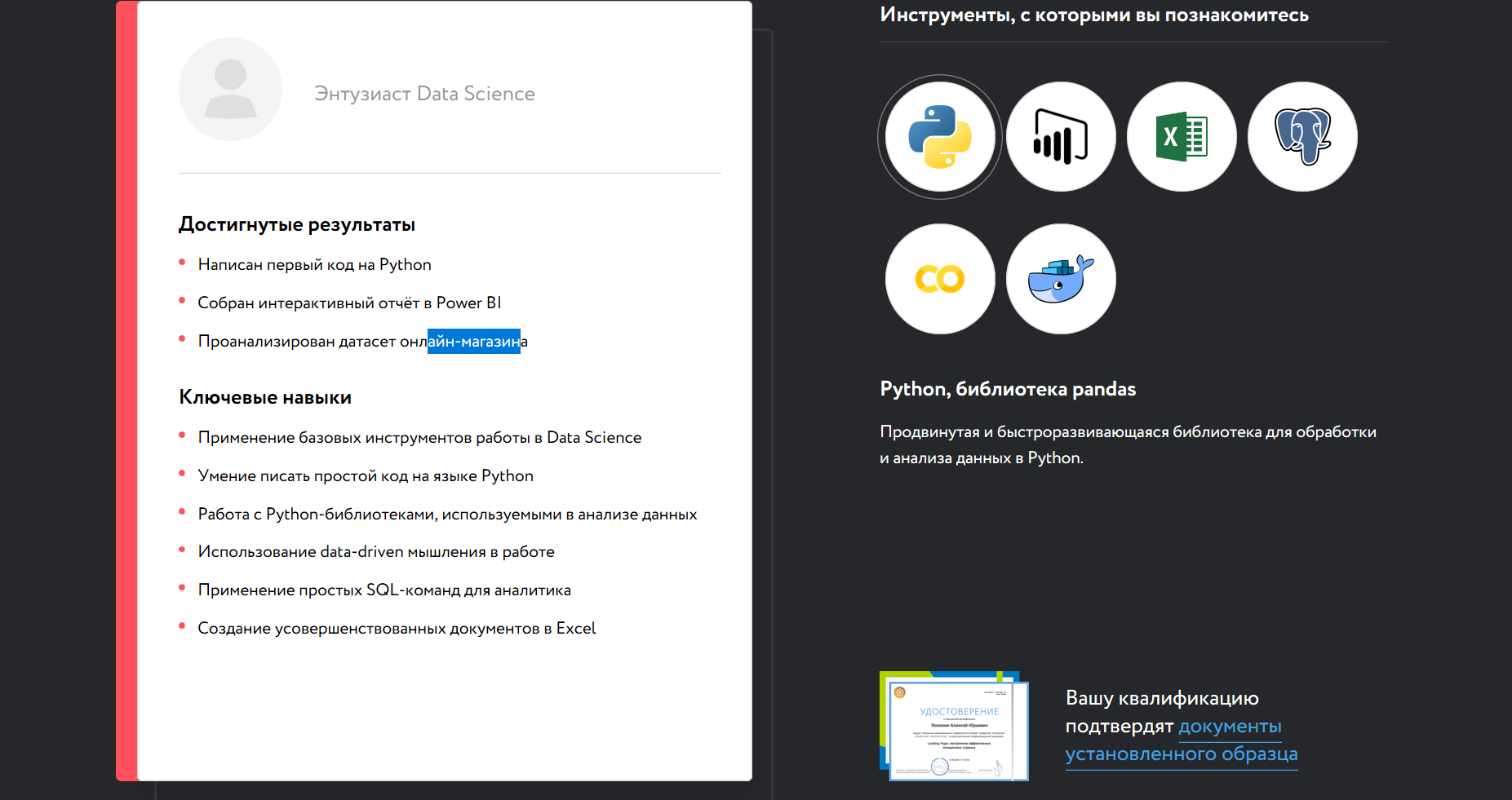For the “thousand years” I haven’t written anything, but suddenly there was an occasion to blow dust off the mini-cycle of publications on “teaching Data Science from scratch”. In the contextual advertising of one of the social networks, as well as on my favorite Habré, I came across information about the course
“Start in Data Science” . It cost mere pennies, the description of the course was colorful and promising. “Why not restore the dusty skills from unnecessary taking the next course?” I thought. Curiosity also played a role, for a long time I wanted to see how the organization of training at this office was organized.
I must warn you right away that I am not affiliated with the course developments or their competitors. All article material is my subjective value judgment with a touch of irony.
And so, you still do not know where it is worth investing your hard-earned 990 rubles? Then you are welcome under cat.

As a short introduction, I’ll say that I’m somewhat skeptical of promising courses that can quickly make a beginner “a successful data analyst with a salary of more than 100,000 rubles” (although you probably guessed that from the title picture of the article).
Several years ago, in the wake of the active advertising of Data Science education, I tried in various ways to master at least something from the field of data science and shared notes about the bumps with Habré readers.
Other cycle articles1. Learn the basics:
2. We practice the first skills
And now, after a long time, I decided to try another course.
Course Description:
Description of the course “Start in Data Science” promises that, having spent only 990 rubles
(at the time of writing), we will receive a four-week course in the format of video lectures and practical exercises for beginners. Also, do not forget about compensation for part of the cost of the course in the form of a tax deduction.
Within the framework of the course, there are two conditional blocks, one will tell you about “Data Science”, what are the popular directions, how you can develop a career in DataScience. The second block considers five tools for data analysis: Excel, SQL, Python, Power BI, and Data Culture.
Well, what sounds “tasty”, we pay for the course and wait for the start date.
In anticipation, we go to your personal account the day before the start of the course, leaf through parting words from the developers and wait for the notification of the long-awaited start of the course.
Time flew by, Day D arrived, you can start training. Having opened the first lesson, we will see the usual scheme for online learning systems - video lecture, additional materials, tests and homework. If you have ever used Coursera, EDX, Stepik then you should not have any problems.
Inside the course:
Let's go in order. The theme of the first lesson is “DS Review: Basis, Benefit, Application”, it begins with a video lecture, like all subsequent lessons.
And from the very beginning it is felt that the comrades were guided by the approach
“So come down” from my beloved Soviet cartoon.
From the first minute you understand that the material for the course was not specially recorded, but was torn from some other open lessons or specialized courses. Also, there are
no subtitles for the video
and the ability to download to view offline.
After the lecture, additional materials were offered for the lesson (presentation from the video lecture and recommended literature), we will not analyze them.
Then a test awaits us. Tests are different in degree of complexity and adequacy of the questions to the material passed.
And here again there is a lack of interest in the result of training, the
test can be flunked, but it will not affect anything , you will still successfully pass the lesson, but the request for an additional attempt to retake will most likely remain unanswered.
Subsequently, the lesson scheme: “video -> ext. materials -> test "- will be the basis of the entire course.
Sometimes the lesson will be diluted with questionnaires and independent homework.
There are only two homework assignments. And to be honest I went through only one thing.
The first homework is to send your resume describing key skills. I can’t say 100%, but it seems to me that almost any resume will be accepted and the task will be taken into account. After the assignment, additional materials will be sent to you - recommendations. Remembering how I was tormented with homework on Coursera, I was even a little upset by such simplicity.
After completing the introductory part, the study of the long-awaited “Tools for getting started in Data Science” begins. And the first is a lesson with a loud heading: "Work in Excel: leveling skills from zero to the analyst."
Wow! It sounds tempting, but in fact the difference between expectation and fact is the same as between a photograph of a hamburger from a fast-food advertisement and what will be given to you at the checkout.
In fact, we will observe how moving from autocomplete cells in Excel to a confusing description of the “VLOOKUP ()” function, the teacher will hesitate like Hamlet on the subject of the topic
“To be, or not to be” “Explain everything for beginners” or “Give interesting material for the pros. " In my subjective opinion, neither one nor the other happened.
It’s especially “cool” that despite the fact that the course does not provide for a live webinar. That is, these are not recordings of those classes that you missed, but simply recordings of classes that were held some time ago (see the figure below), the authors still decided to keep the atmosphere
(or maybe just too lazy) and
make you watch for five minutes how the teacher solves problems with sound .

After the video according to the standard scheme follow - additional material and test.
The next topic is about the SQL language. The lesson gives the very basics and examples of working with SQL queries, in principle, videos and articles on a similar topic can be
easily found on the Internet for free .
Behind SQL there is a lesson on handling dataset with Kagle using the Python library “Pandas”. The lesson scheme has not changed: video -> ext. materials -> test. No additional tasks are provided, there is not even a task with automatic verification of results. Thus, you don’t have to install “Anaconda” and write the code. It is also
worth noting the small font of the code in the video lecture , it is pointless to watch it on the phone, and I had to look almost point-blank at the monitor.
The fourth lesson is “Visualization of the logistics report in the PBI in 10 minutes”
( 50) . This video will tell you about a curious Power BI tool, to be honest, I have never heard of it before.
Unexpected completion of the course:
The final fifth lesson will tell you about the general principles of competent data storage, the lecture is again torn from another course. In this lesson, in addition to the standard test, homework appears again, but I did not do it. Want to find out why?
Because, having opened today the page of a course that was only half completed, I saw this:

That is, the
system considered that I successfully completed the course, although in fact I did not complete it .
Moreover, after watching all the remaining videos and conducting tests, the counter did not change, but remained at 56%. I suppose that I
could not watch anything and not pass the tests and still get the "Diploma" .
It is especially surprising that the newsletter officially lasted from July 22 to August 14, and the Diploma was issued to me on 04/04/2019.
Learning outcomes
The company’s website, upon completion of training, promises us: “Your qualifications will be confirmed by established documents.” But the trouble is, this course seems to be neither a retraining program, nor a continuing education program, which means you will simply receive a
“certificate”, which in principle does not have an official status .
Probably, the question will be reasonable: “What did you expect for 990 rubles?”. To be honest - I did not expect anything. It is clear that quality courses are much more expensive. But the trouble is that there are free courses that are made not at least as well as at times more professionally, for example, courses from
MVA or from the
Cognitive Class . The same “certificate” of the course (if anyone needs it), there
you can get absolutely free .
From the advantages, it can be noted that these survey materials are collected in one place and it will be really easier for a person completely unfamiliar with Data Science to navigate in this area.
At the end of the course, they promise us that we will learn a bunch of tools, and in our resume we can write like this:

In fact,
this is a very strong exaggeration . You will essentially hear about many tools and no more.
Summary
In my opinion, the course carries a minimum of payload, especially sad that the authors were too lazy to record separate video lectures for him. In a good way it’s a shame to ask for money, or you need to ask 10 times less.
But once again I repeat that all of the above is only my subjective value judgment, whether you should take this course or not is up to you.
PS Perhaps with time the authors of the course will finalize it and all criticism in the article will lose relevance.
Just in case, I’ll write that it is valid for the very first launch of this course from July 22 to August 14
UPD: The authors of the course in a personal message promised to correct the shortcomings.UPD2: Thanks to everyone for the proposed corrections!